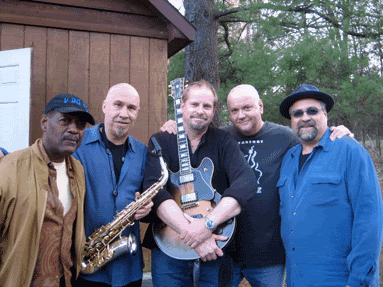 by Pico
by Pico
At this time last year the sizzling straight-jazz band headed up by guitarist Dave Stryker and saxophonist/flautist Steve Slagle had a record out that we were making hay over, entitled Latest Outlook. The boys are back already with another batch of mostly original tunes called The Scene. And like before, they brought in that titan of the tenor Joe Lovano to sit in for several tracks.
Hey it worked so well the last time, so why not do it again?
For The Scene, released on October 14, the solid and ever-busy Jay Anderson is retained on bass, but they did mess with the lineup at the drum chair, where the magnificent Billy Hart is replaced by the equally magnificent Victor Lewis.
Recorded in a single day at Anderson’s Mountain Rest Studio in upstate New York, the boys brought big city urgency to a relaxed setting. Many of these new tunes had already been tested in front of live audiences and combined with the high caliber of each musician to a man, there wasn’t going to be any need to dilly-dally around. They could get right down to business, and that’s just what they did.
The title cut “The Scene” proves that Stryker didn’t just learn the ins and outs of playing soul jazz from gigging with Jack McDuff and Stanley Turrentine, he mastered the art of composing songs in that vein, too. Even though this song would work great with an organ, Stryker’s skillful comping makes you not miss it, either.
“Kindred Spirits” is this album’s nod to Metheny-esque Americana folk that Stryker likes to throw in for a pleasant change-up. Stryker dubs an electric guitar on top his acoustic rhythm for some lead work and gives his most inspired solo of the album. Slagle does manage not to be overshadowed when his turn comes, though.
Rahsaan Roland Kirk’s “Fingers In The Wind” is the lone cover, a lesser-known composition from his classic The Inflated Tear album. It’s just Slagle on a very lyrical flute backed only by Stryker’s soft rhythm colorings. The flawless execution is more remarkable given that this track was cut on the fly in a single take.
Slagle’s “Hopewell’s Last,” a paean to his late brother Stuart, again pairs up the sopranoist with the famous tenorist in a bluesy dirge that’s a close cousin to Thelonius Monk’s “Pannonica.” Slagle’s solo is appropriately mournful while Lovano goes the more meditative route.
The next track “Brighter Days,” counters with a snappy but loose tempo, and is another soulful burner from Stryker. Lovano gets plenty of room to weave some thoughtful lines and he takes advantage of it.
Other highlights include the opener “Skee” with its memorable horn-led theme and hot solos from Slagle, Lovano and Stryker; the breezy “Six Four Teo,” and the slippery blowing session that is “Strikology.”
Just as with Latest Outlook, the Stryker-Slagle Band doesn’t seek to stake out new ground in jazz, but instead hits the mark with well-written, original tunes and maximal musicianship. The Stryker-Slagle Band revisits the well traversed post-bop ground with the enthusiasm and acumen that makes it sound fun and fresh to listen to. They once again show that honoring a proud tradition is meant to be a labor of love not some academic exercise.
- Nick Millevoi – ‘Moon Pulses’ (2024) - April 23, 2024
- Cannonball Adderley – ‘Poppin’ in Paris: Live at L’Olympia 1972′ (2024) - April 20, 2024
- Christian Marien Quartett – ‘How Long Is Now’ (2024) - April 18, 2024



